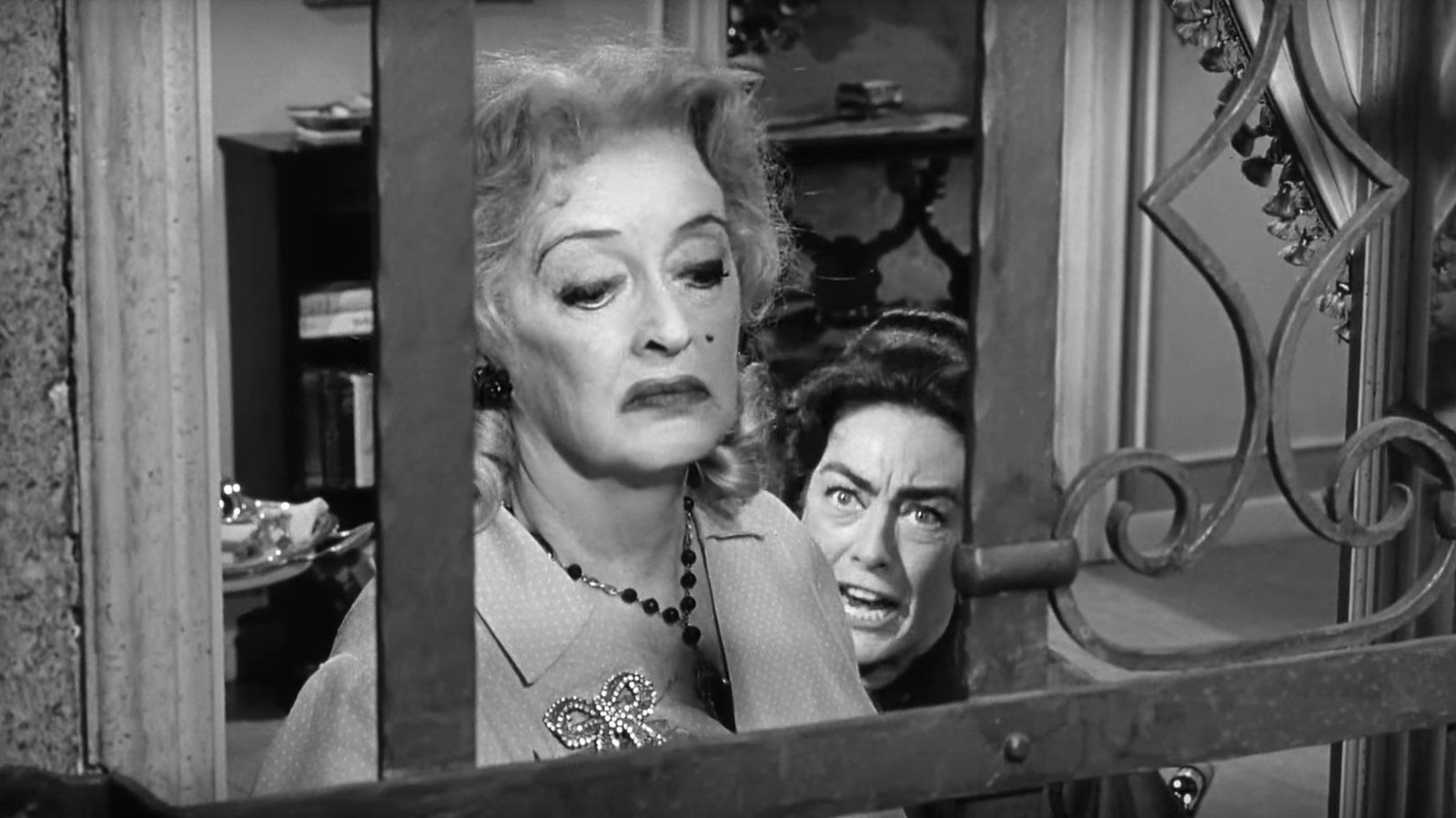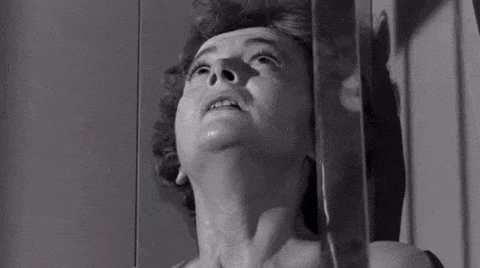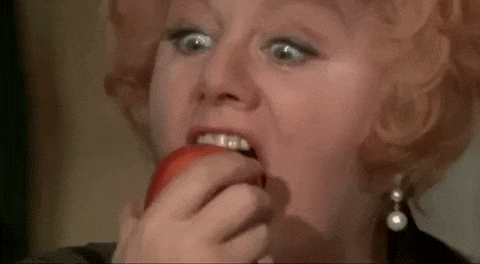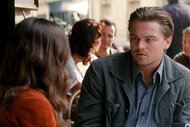Create a free profile to get unlimited access to exclusive videos, sweepstakes, and more!
A primer for the unexpectedly awesome hagsploitation horror subgenre

October may be almost over, but there's always time to watch more horror films. Once you've gotten the blood 'n' guts out of the slashers out of your system, consider a look back at some of the classics. Consider, if you will… the psycho-biddy.
The psycho-biddy is the figure at the center of the "hagsploitation" — also known as "hag horror" or "grand dame Guignol" — genre, a particular subset as horror that has as a prerequisite for its existence Hollywood's disdain for older women... that, in subversive fashion, gives these women some of the best roles of their later careers.
Hagsploitation came onto the scene, roaring and with a face covered in pancake makeup, following the success of 1962's What Ever Happened to Baby Jane?. The movie famously pitted rivals Joan Crawford and Bette Davis against one another as past-their-prime actress sisters; behind-the-scenes, both Crawford and Davis had seen a substantial dip in popularity prior to the film's release. The two actresses were among a group of women that had, in a very real way, built Hollywood — only to find that, once they hit a certain age, the studio heads for whom they made so much money no longer had much use for them. Popularity waned. Offers for leading roles were hard to come by — until Baby Jane director Robert Aldrich stumbled on a formula: Take these actresses whom audiences were so familiar with. Take the glam down by a few notches. Turn the acting up by more than a few notches. Magic was born.
In the "hagsploitation" genres, greats from the Golden Age of Hollywood — to put it in simple terms — go full goddamned crazy in melodramatic thrillers that play on audiences' memory of them as gorgeous goddesses of the silver screen. Baby Jane invites us into a world where Joan Crawford and Bette Davis are — gasp! — old and ugly, playing into the public's cruel curiosity about those once at the height of fame and success who have fallen on hard times.
Hagsploitation wouldn't exist without this fascination-cum-schadenfreude paired with a revulsion of older women, who in the world of the psycho-biddy always seem mere seconds away from hauling out an ax and splitting someone's head open. But in the world of the psycho-biddy, public distaste for women, older than 50 serves as a Trojan horse — because in psycho-biddy horror, the psycho-biddy always takes center stage.
Those who love What Ever Happened to Baby Jane? would do well to check out Hush… Hush, Sweet Charlotte, the second most famous psycho-biddy film, also directed by Aldrich. The director teams once again with Davis, who this time plays a kooky old shut-in whose house is about to be torn down. Also, she might have killed her boyfriend when she was younger; a hagsploitation movie isn't a hagsploitation movie without a mysterious death lurking in the background. To help her keep her house, Davis' character calls in a cousin, played by Olivia de Havilland. (The role originally went to Crawford, whose early departure from the film involved Davis messing with her head until she checked into a hospital.) Also in the mix are Mary Astor (The Maltese Falcon) and Agnes Moorehead, who, just months prior to Hush's release, had debuted the role that would prove her most famous: Endora in Bewitched.
Basically, this is a lot of super-talented women over 40 for one movie! The movie has men in it, of course, but it's the women who drive the action and are at the center of all the meaty scenes. One gets the sense watching Charlotte and Hush that its actresses are competing with each other just as its characters are: for accolades, for screen time, for who can turn in the most delightfully bug-f*** performance. This is definitely true of Davis and Crawford in Baby Jane; both actresses were extremely competitive, but let's not overlook Moorehead's performance in Hush. She plays Davis' country bumpkin maid, a side character, but one so delightfully unhinged that she's able to pull focus away from Davis, sporting an over-the-top Southern accent, shrieking "You're a vile, sorry little bi*ch!"
...and "DEEEAAAAAD! HE'S DEEEEAAAAAAAAADDDDD!"
A bit at sea here, regrettably, is De Haviland, who just has too much restraint as an actor to fully bring the insanity. There are some brief, shining moments of hagsploitation brilliance in Walter Grauman's Lady in a Cage, where her character's tendency towards internal monologues gives De Haviland the opportunity for some truly brilliant face acting:
Most of the time, men in the hagsploitation genre read almost as an afterthought. They're there as plot setup, to jilt or be jilted, or maybe to be murdered or do some cursory investigating into Mysterious Circumstances. But it's these actresses we're there to see, and everyone knows it. In how many other genres do we consistently get that, especially when we're talking about middle-aged women?
It's beautiful and wonderful and special that a film like What Ever Happened to Aunt Alice?, produced by Aldrich but directed by Lee H. Katzin, even exists. Geraldine Page — who by the time Aunt Alice came out had four Oscar nominations, two Tony nominations, and two Emmy wins under her belt — plays a widow flabbergasted by the fact that her late husband left her no money. Refusing to give up her lavish lifestyle, she comes up with a plan: She'll just trick a whole bunch of housekeepers into giving her their money, kill them, and bury their bodies in her front yard. As one does. Playing opposite Page is Ruth Gordon, fresh off her Oscar win for Rosemary's Baby. The film reads like a more twisted, cynical Murder, She Wrote, with Page and Gordon engaged in a game of cat and mouse that will end with at least one dead body. It's magnificent.
After Baby Jane, the hagsploitation genre took off. It attracted the attention of B-movie legend William Castle, who never met a gimmick he didn't love and subsequently milk for all its promotional value. The often schlocky director brought moody, Gothic visuals and an admirable-if-unusual sense of restraint (but not too much restraint) to The Night Walker, which saw Barbara Stanwyck streaming her way through her final movie as a widow who suspects her nightmares may be actually happening. Castle collaborated with Crawford on hagsploitation classic Straight-Jacket, as well as Berserk! (in which Crawford plays a circus ringmaster who spits out the line "We're running a circus, not a charm school!") and I Saw What You Did, where two teenage girls learn the dangers of making prank calls and Crawford wears this gigantic f*ck-off necklace.
Another big name in the hagsploitation genre is Curtis Harrington, director of Whoever Slew Auntie Roo? and What's the Matter with Helen? (you'll notice a certain naming convention at play here). You can't have a genre defined by "grand old actresses going f***ing nuts" and not have Shelly Winters; she's in both of these films, in Helen sharing top billing with Debbie Reynolds. Auntie Roo is a weird, twisted little take on Hansel and Gretel, with Winters playing a retired actress who is suspected by a pair of orphan siblings of wanting to cook and eat them. The conceit gives Winters the opportunity to engage in some truly dramatic apple-eating, and really, what else do you need?
Less over-the-top than Baby Jane or Charlotte— but still worth watching — Helen has Winters playing the co-dependent BFF of Reynolds' character. Reynolds finds a man, and Winters doesn't take it well. Said Winters in an interview of her Helen character, "They didn't want me to play [the lesbianism] too directly, but I did." Unspoken queerness is also to be found in Aunt Alice, where you don't even have to read between the lines to realize that Ruth Gordon's desperate determination to find out what happened to the eponymous Alice comes from a past romantic relationship. Worth noting here is that Harrington himself is considered one of the early pioneers of New Queer Cinema.
In starting from the subversive — "Let's make a movie about middle-aged women" — the psycho-biddy genre has leeway to explore other at-the-time taboo subjects. In the more understated The Nanny, starring Bette Davis, one character abandons a child and the other has a back-alley abortion. The lesbianism is front-and-center in Aldrich's 1968, psycho-biddy-adjacent The Killing of Sister George, about an aging soap opera actress (Beryl Reid) who begins to unravel when she hears that her character's about to be killed off; she also worries that her young lover (Susannah York), with whom she has a dysfunctional, domineering relationship, will be seduced away by someone else. The film received an X rating for an explicit lesbian sex scene.
Hagsploitation had its heyday throughout the '60s. It was a time of rebirth for horror, as films like Psycho, Rosemary's Baby, Repulsion, and Night of the Living Dead revitalized the genre. Compared to those, hagsploitation may seem retrograde, as much for their campy, bizarre plots as for their use of actresses popular from earlier decades. They have more in common with the excess of Hammer horror (also popular during this era) than Hitchcock.
Still, there's something that feels fresh about hagsploitation films. There's a loss of inhibition to be found in a film like What Ever Happened to Baby Jane?, Straight-Jacket, or Dead Ringers, in which Davis plays estranged twin sisters, one of whom murders the other. These honest-to-God screen legends may be slumming it, but by God, slumming it means the gloves can come off. In the very best hagsploitation films, restraint is a four-letter word.




























